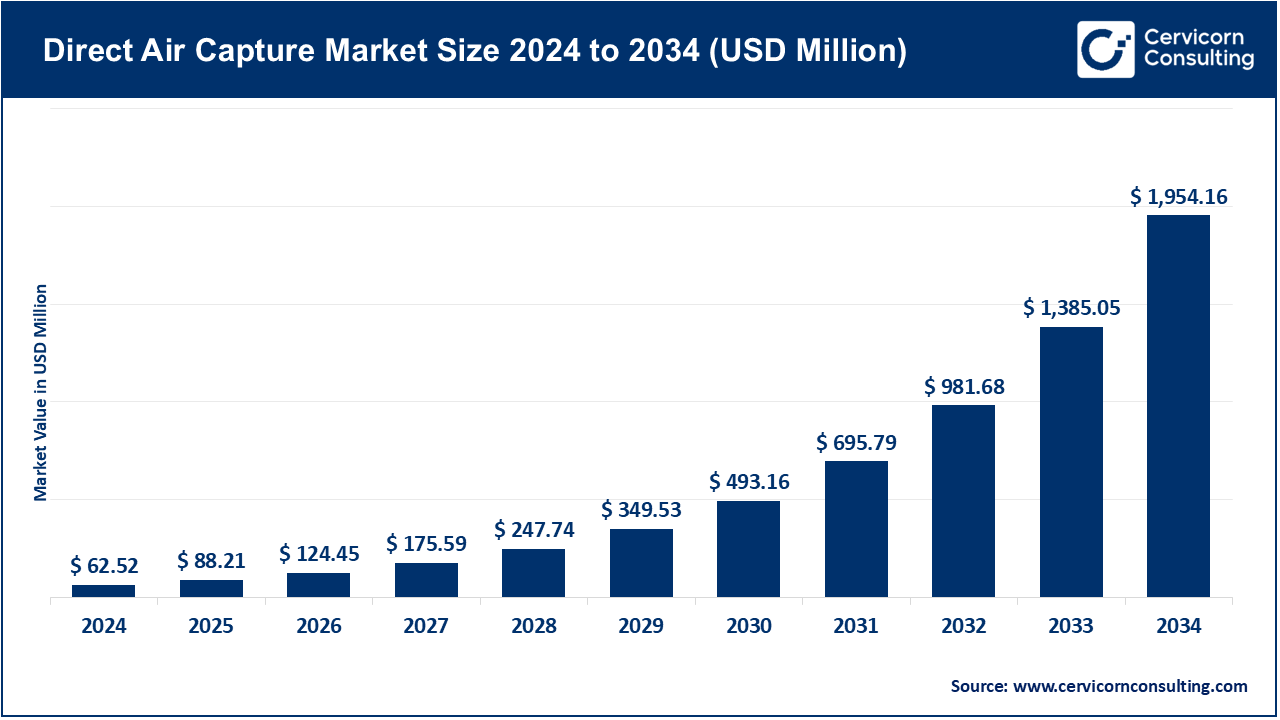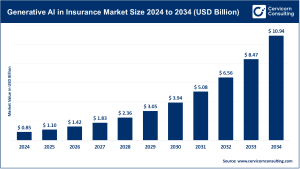Direct Air Capture Market Overview (2024–2034)
The global direct air capture market was valued at around USD 62.52 million in 2024 and is projected to expand to nearly USD 1,954.16 million by 2034, growing at a CAGR of 49.5% from 2025 to 2034. DAC technology captures CO₂ directly from the atmosphere using chemical solvents or solid sorbents. The captured CO₂ can either be permanently stored in geological formations or repurposed across industries such as synthetic fuels, building materials, beverages, and enhanced oil recovery. Unlike conventional point-source carbon capture, DAC operates in ambient air, enabling flexible siting and scalable carbon removal solutions.
Key Market Trends
-
Commercialization and Investment Acceleration: The industry is shifting from experimental pilots to commercially operational DAC systems. Strategic alliances, corporate offtake agreements, and major funding rounds in 2025 highlight the market’s progression toward revenue-generating deployments.
-
Renewable Energy Integration: DAC installations increasingly leverage renewable energy to minimize operational emissions and reduce reliance on fossil fuels. For example, Project Concho in West Texas is a wind-powered DAC facility targeting the capture of 50,000 tCO₂, underscoring the trend toward low-carbon operations.
-
Technological Advancements: Innovations in sorbent and solvent efficiency, modular chemical processes, and electrochemical DAC enhance CO₂ capture rates and lower energy consumption. Solid-DAC systems held approximately 58.3% market share in 2024 due to their modularity and industrial scalability.
-
Modular and Scalable Deployment Models: Smaller collector systems (fewer than 10 units) dominate pilot and demonstration projects, allowing incremental scaling and flexible siting. Modular designs reduce capital expenditure and simplify installation across industrial and regional contexts.
-
Policy and Regulatory Support: Governments are establishing incentives, grants, and supportive frameworks to stimulate DAC adoption. In North America, approximately 48.3% of the market in 2024 was driven by strong policy backing and abundant geological CO₂ storage sites.
Market Drivers
-
Government Funding and Incentives: In 2025, the U.S. Department of Energy allocated USD 3.5 million to develop four DAC hubs under the Bipartisan Infrastructure Law, aiming to capture at least one million tonnes of CO₂ annually.
-
Corporate Net-Zero Commitments: Key industrial players in aviation, cement, and oil & gas are securing long-term carbon removal contracts to meet sustainability targets.
-
Technological Efficiency: Advances in solid and liquid sorbents, electrochemical DAC, and energy integration have reduced the per-ton cost of CO₂ removal, boosting market adoption.
-
Global Climate Obligations: Tightening emissions regulations and a global push toward sustainable industrial growth are increasing demand for DAC solutions.
Impact of Trends and Drivers
-
North America: Leading the global market due to regulatory support, funding, and extensive CO₂ storage infrastructure.
-
Europe: Strong climate policies, renewable energy integration, and permanence standards attract modular DAC deployments.
-
Asia-Pacific: Potential growth in industrial clusters and island nations depends on regulatory clarity and carbon credit frameworks.
-
Latin America, Middle East & Africa: Emerging opportunities exist where DAC can be combined with blue hydrogen and geological CO₂ storage, though adoption relies on infrastructure and local incentives.
Challenges & Opportunities
-
Challenges: High upfront capital costs, energy-intensive operations, and limited awareness of DAC technology remain hurdles. Regulatory inconsistencies across regions can also impede adoption.
-
Opportunities: Advances in technology, modular deployment models, and increasing private-sector offtake agreements provide growth prospects. New applications for CO₂ utilization—such as synthetic fuels, green chemicals, and building materials—are enhancing market revenue potential.
Future Outlook
The DAC market is expected to experience significant growth over the next decade, with a projected CAGR of 49.5%. By 2034, the market could reach USD 1,954.16 million, driven by technological improvements, scalable modular deployments, policy incentives, and expanding corporate and governmental carbon removal commitments. Emerging trends, including renewable energy integration, electrochemical DAC, and distributed modular systems, will shape the competitive landscape, positioning DAC as a key technology in global carbon management strategies.
For more details, visit: Direct Air Capture Market.

